No matter how much research you’ve done and how many experts you’ve consulted about the best type of grass for your lawn, your grass won’t thrive unless it’s planted in healthy soil.
In just two minutes, expert landscapers Daniel and Shannon guide you on how to prepare your soil for sod installation.
Conduct a Soil Test
Sample the soil in the area you plan to sod and send it for testing to determine the need for additional nutrients. Submit the sample at least 14 days before you plan to add soil amendments.
Kill Existing Vegetation
To ward off any competition for your new sod, you’ll need to kill any existing vegetation that is currently growing in your lawn. We have a couple of different options, depending on lawn size and chemical-use preference.
If you are a fan of the herbicide route, spray the existing lawn with a kill-all herbicide containing glyphosate at least 7-10 days before you plan to sod. This will destroy whatever it touches; therefore, wear protective gloves and carefully follow all label directions to ensure safety for both you and your lawn. Not all plants are created equal. You may need to spray more than once to defeat some grass.
As a natural alternative, smother vegetation by using tarp and the summer sun. Cover the entire area with a opaque tarp, secure it to the ground, and allow the grass to languish in the heat. This could take 1 to 2 months. If you’re patching up a small area, this method may require less effort than spraying.
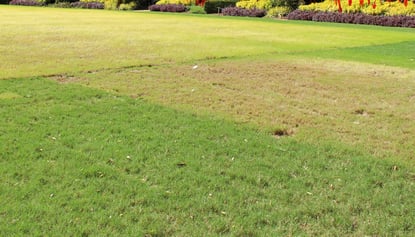
This grass has been under an opaque tent for 10 days. While it is suffering now, it will take several more weeks to kill it completely.
Fungus-prevention tip: It is never acceptable to lay your new sod on top of existing grass, whether dead or alive. Laying sod on top of other grass can result in fungus problems.
Till Your Soil & Vegetation
Use a tiller to loosen up that dead vegetation. You’ll want to till up at least 3”-4” of the soil. Grass roots need a loose soil base to begin their growing process.
Tiller back-saver tip: if you rent a tiller, look for a rear tine model. These are easier on your back than the tillers with blades in the front.
Rake Out the Dead Vegetation
Use a rake to separate the vegetation from your newly tilled soil. Be sure to leave as little as possible behind. The roots of old grass and weeds could sprout and compete with your new sod for resources if they were not completely destroyed chemically or naturally.
Use this raking time to remove any sticks, rocks, or debris from your planting site as well. The fewer obstacles in your lawn, the better.
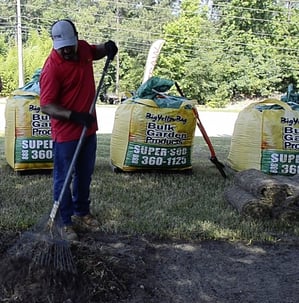 Rake up dead vegetation after tilling. Make sure to remove roots so they don't germinate later.
Rake up dead vegetation after tilling. Make sure to remove roots so they don't germinate later.
Add Compost to the Soil
Compost is the best option for giving your grass a healthy start because of its pure nutrition. As opposed to topsoil, there are higher standards to qualify as compost for commercial sale.
We recommend one cubic yard of compost per every 1,000 square feet of sod, or one cubic foot of compost for every 20 square feet of sod.
Our favorite, of course, is Soil3 organic compost, available for delivery in a BigYellowBag or at Super-Sod stores for pick-up in Mini Cubes.
Spread the compost into your newly turned soil by shovel or with a compost spreader. If your soil test results indicated a need for a particular element in your soil, spread the fertilizer or lime at this point.
Now, rake the compost into the soil, making sure to get it as level as possible.
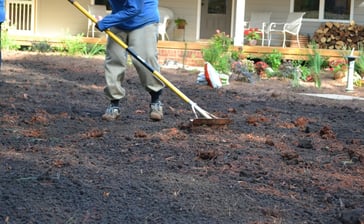
Rake compost into your tilled topsoil before laying sod.
Admire Your Healthy New Soil
Now you’re ready to lay your sod on a healthy base. Luckily, there are some specific instructions and a video detailing the best way to do this on the Super-Sod site. Follow the directions for the best results.
Ready to prepare healthy soil for your lawn? Find your nearest Soil3 distributor.
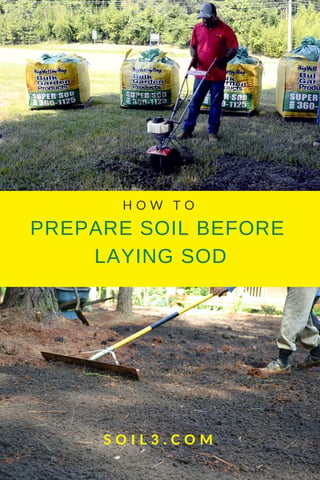
![How To Build a Dry Stack Stone Wall and Backfill with Soil [Video]](https://blog.soil3.com/hs-fs/hubfs/Soil3%20BLOG/finished-dry-stack-stone-wall.png?width=300&name=finished-dry-stack-stone-wall.png)
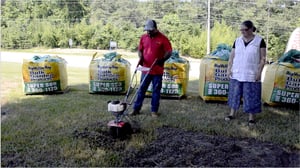

![How To Build a Dry Stack Stone Wall and Backfill with Soil [Video]](https://blog.soil3.com/hs-fs/hubfs/Soil3%20BLOG/finished-dry-stack-stone-wall.png?width=300&name=finished-dry-stack-stone-wall.png)
![Choosing the right compost spreader for natural fertilization [Video]](https://blog.soil3.com/hs-fs/hubfs/Soil3%20BLOG/compost%20spreader%20video%20thumbnail.jpg?width=300&name=compost%20spreader%20video%20thumbnail.jpg)
![Growing Giant Watermelons with a North Carolina Champion [video]](https://blog.soil3.com/hs-fs/hubfs/Soil3%20BLOG/Todd%20Dawson%20and%20his%20watermelon.jpg?width=300&name=Todd%20Dawson%20and%20his%20watermelon.jpg)
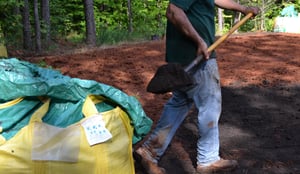
![Growing a Giant Pumpkin on a Scale with Danny Vester [Video]](https://blog.soil3.com/hs-fs/hubfs/Danny%20Vester%20and%20his%20pumpkin.jpg?width=300&name=Danny%20Vester%20and%20his%20pumpkin.jpg)
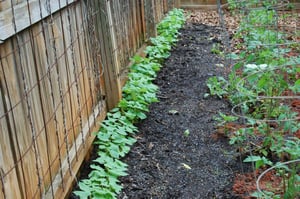
Did this help you out? Have any questions for clarity? Leave a comment below!